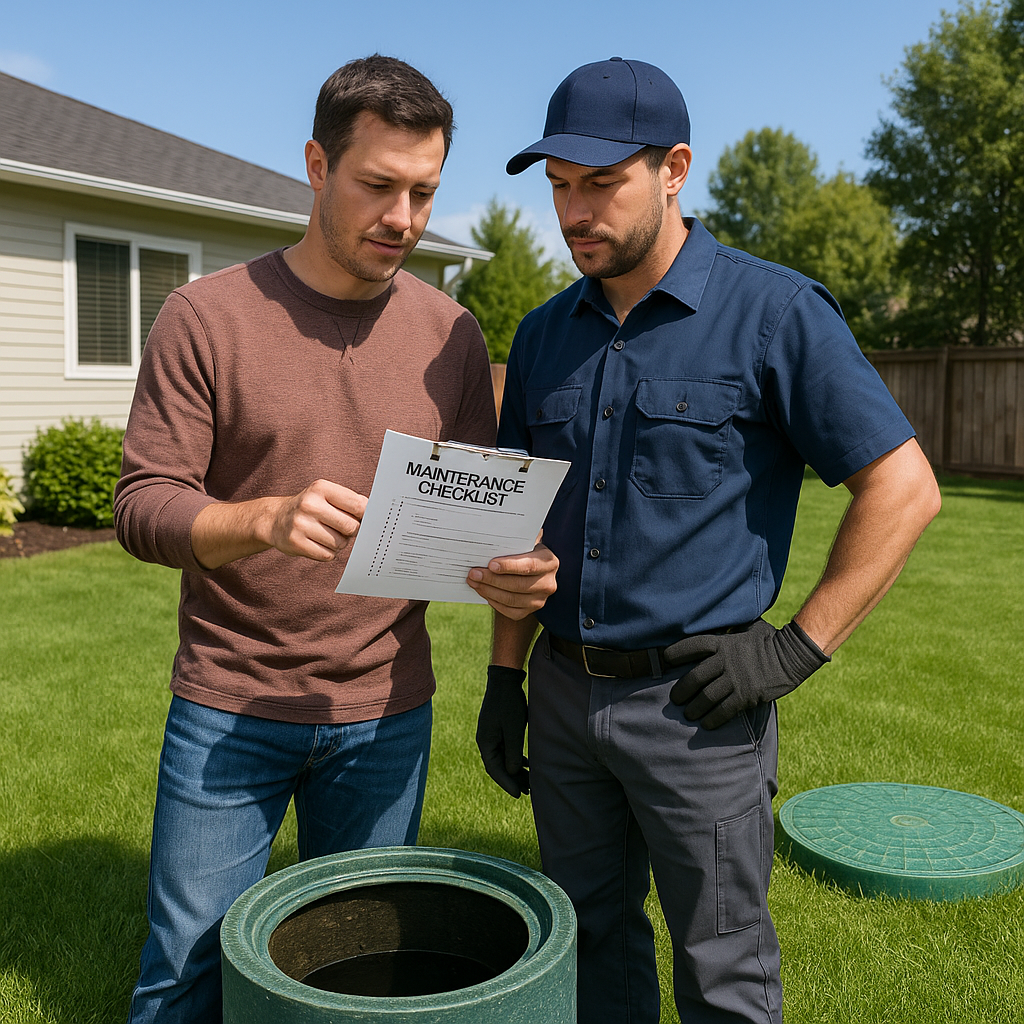Have you ever wondered if your septic system is quietly breaking a rule you didn’t even know existed? It’s easy to overlook septic system maintenance rules until a surprise inspection or costly fine shows up at your door. Staying compliant isn’t just about avoiding septic system violation penalties; it’s about protecting your home, your wallet, and your environment.
This septic tank compliance guide was created to make things simple. We’ll break down the key residential wastewater regulations every homeowner should know, using plain language and real-world examples. No jargon, no overwhelming legal speak—just practical information you can actually use.
Understanding these sewage disposal standards matters more than you might think. Following proper homeowner septic responsibilities keeps your system running smoothly, prevents expensive repairs, and helps safeguard local water supplies. It also helps you stay prepared for septic inspection requirements when you sell your home or apply for a permit.
By the end of this guide, you’ll know exactly which state septic laws apply to you, why they’re important, and how to stay compliant without unnecessary stress. With a few simple actions, you can maintain compliance, avoid headaches, and protect one of your home’s most essential systems—all while ensuring peace of mind and environmental safety.
Understanding Septic Tank Regulations: A Brief History and Today’s Landscape
Septic systems have existed for over a century, first popularized in rural areas relying on private sewage disposal. Early septic tank installation codes were minimal, often leading to groundwater contamination and expensive cleanups. As awareness of environmental health regulations grew, government agencies stepped in to ensure systems were safely installed, maintained, and repaired.
A septic system is part of onsite sewage management, designed to treat and disperse wastewater naturally. Components like the drainfield, governed by septic drainfield standards, ensure filtered water safely reenters the soil. Regular maintenance—especially following the proper septic tank pumping frequency—prevents clogs, system failure, and fines.
Modern rules now include local septic permit process requirements, septic permit applications, and routine inspections. Strict effluent discharge limits, septic setback distances, and mandatory septic design approvals help protect community water sources. Some areas even offer incentives for septic system upgrades that improve energy efficiency and treatment quality.
By understanding how rural septic regulations evolved, you can better navigate your septic contractor licensing requirements and ensure your septic compliance certificate remains current. Whether you’re maintaining an old system or installing a new one, staying informed about these historical and modern standards empowers you to make responsible, compliant decisions for your property.
Key Elements of Septic Tank Compliance Every Homeowner Should Know
At its core, septic compliance ensures your system safely processes wastewater without harming your property or the environment. Knowing these septic system enforcement policies helps you plan maintenance and avoid last-minute surprises.
Here are the core elements that make up septic tank compliance:
- Permits and Approvals – You’ll need septic system repair permits or authorization before installing or modifying a system. These ensure your setup meets state septic laws and passes soil percolation test rules.
- Regular Inspections – Scheduled septic inspection frequency helps detect leaks, backups, or septic tank failure signs before they worsen.
- Pumping and Maintenance Records – Keep organized septic tank record keeping for every septic maintenance service or septic maintenance contract you complete. It’s also crucial for property transfer septic requirements during home sales.
- Setback and Placement Rules – Follow septic tank location requirements and septic tank zoning laws to prevent contamination of wells or nearby water sources.
- System Upgrades and Replacements – Comply with septic system replacement rules and septic tank cleaning maintenance tips to meet new standards.
Applying these rules doesn’t just protect you from penalties—it extends your system’s life, keeps your property value strong, and safeguards the environment around you.
The Big Wins of Staying Septic Compliant
Staying compliant with residential wastewater regulations offers many long-term advantages that go beyond avoiding fines. Proper care supports sustainable living and financial security for homeowners.
- Avoid Costly Repairs and Fines – Following septic system maintenance essentials and keeping up with inspections minimizes septic tank inspection cost and helps prevent septic system violation penalties.
- Protect Property Value – Maintaining your septic tank certification proves to buyers that your system is up to code and properly maintained.
- Safeguard Local Water Quality – Adhering to effluent discharge limits and sewage disposal standards prevents harmful waste from entering groundwater, protecting community health.
- Extend System Lifespan – Regular septic tank emptying service and inspections can extend your system’s useful life by decades.
Beyond these benefits, compliance ensures you meet all environmental health regulations, which contributes to cleaner ecosystems and healthier communities. Maintaining onsite sewage management is both a personal responsibility and a civic contribution. By taking small, consistent actions like record-keeping and pump scheduling, you protect your investment and reduce future risks while keeping your surroundings safe and sustainable.
Navigating the Challenges of Septic Tank Compliance
Compliance isn’t always easy. Understanding septic system enforcement policies, managing septic permit applications, and maintaining regular inspections can feel like a full-time job—especially for new homeowners.
Common challenges include:
- Complex local septic permit process differences from one county to another
- High upfront costs for septic system upgrades or replacements
- Limited access to professionals with valid septic contractor licensing
You can simplify compliance by staying informed about state septic laws, setting aside an annual maintenance budget, and partnering with a trusted septic maintenance contract provider. Maintaining an organized septic tank inspection checklist helps streamline inspections and septic compliance certificate renewals.
Don’t view compliance as a burden—it’s a protective measure. Understanding these processes prevents septic emergencies, ensures consistent septic inspection frequency, and saves you from costly issues later. With preparation, even the most detailed environmental health regulations become manageable.
How to Put Septic Tank Compliance Into Action
Understanding the rules is just the beginning—now it’s time to apply what you’ve learned from this septic tank compliance guide.
- Review state septic laws and verify your local septic permit process online or at your health department.
- Schedule regular inspections to meet septic inspection requirements and assess septic system environmental impact.
- Maintain your septic system maintenance schedule and keep records of all septic permit applications.
- Practice consistent record keeping and verify your septic tank certification is up to date.
- Budget for essential upgrades and repairs to stay within compliance.
Digital tools and reminders can help track your septic tank emptying process, inspection frequency, and maintenance services. Monitoring septic drainfield standards over time ensures your system remains efficient and environmentally safe.
By following these steps, compliance becomes second nature. Homeowners who plan ahead, stay organized, and maintain awareness of residential wastewater regulations can prevent problems before they start—and protect their homes for years to come.
Wrapping It All Up: Staying Compliant and Confident as a Homeowner
Understanding septic system maintenance rules allows you to confidently manage your homeowner septic responsibilities while protecting your property. Keeping consistent septic tank record keeping, maintaining proper septic inspection frequency, and adhering to sewage disposal standards all contribute to a strong, healthy, and compliant system.
Avoiding septic system violation penalties isn’t the only goal—long-term system health and community safety matter most. Reviewing your local septic permit process, ensuring compliance with septic tank installation codes, and following all environmental health regulations will help maintain lasting performance.
By taking small, consistent steps—like scheduling inspections and working with certified professionals—you ensure your system remains efficient, environmentally friendly, and legally compliant. Septic tank compliance isn’t just about following rules; it’s about preserving your home, protecting local water quality, and maintaining peace of mind for years to come.






